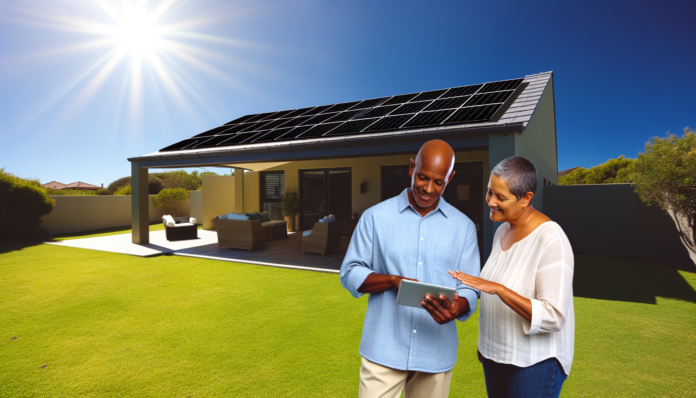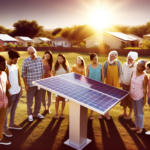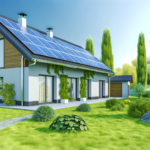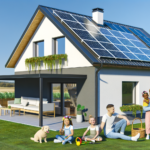Introduction to Solar Power
What is Solar Power?
Solar power is the conversion of energy from sunlight into electricity. This can be achieved through various technologies, the most common being photovoltaic (PV) cells, which are used in solar panels. These cells capture sunlight and convert it into direct current (DC) electricity. This DC electricity is then converted into alternating current (AC) electricity using an inverter, making it suitable for use in homes and businesses.
Benefits of Solar Power
Solar power offers numerous benefits, making it an attractive option for energy generation:
- Renewable Energy Source: Solar power is a renewable resource, meaning it won’t deplete over time. As long as the sun shines, we can harness its energy.
- Reduces Electricity Bills: By generating your own electricity, you can significantly reduce or even eliminate your monthly electricity bills.
- Low Maintenance Costs: Solar power systems generally require minimal maintenance. Regular cleaning and occasional professional check-ups are usually sufficient to keep the system running efficiently.
- Environmentally Friendly: Solar power is a clean energy source that produces no greenhouse gas emissions, reducing your carbon footprint and helping combat climate change.
- Energy Independence: By generating your own electricity, you become less reliant on the grid and more resilient to power outages and price fluctuations.
Why Choose Solar Power?
Choosing solar power is a decision that can have a profound impact on both your finances and the environment. Here are some compelling reasons to consider making the switch:
- Cost Savings: While the initial investment in a solar power system can be significant, the long-term savings on electricity bills can be substantial. Additionally, many governments offer incentives and rebates to offset the initial costs.
- Environmental Impact: By choosing solar power, you contribute to reducing harmful emissions and promoting a cleaner, healthier planet. This is a crucial step in addressing global climate change.
- Technological Advancements: Solar technology is continually improving, making systems more efficient and affordable. Innovations such as solar batteries and smart inverters are enhancing the performance and reliability of solar power systems.
- Increased Property Value: Homes equipped with solar power systems often see an increase in property value. Potential buyers are attracted to the prospect of lower energy bills and a sustainable energy source.
- Energy Security: Solar power provides a reliable source of energy that is not subject to the volatility of fossil fuel markets. This stability can be particularly beneficial in regions prone to energy shortages or price spikes.
In summary, solar power is a versatile and sustainable energy solution that offers numerous benefits. Whether you’re motivated by cost savings, environmental concerns, or energy independence, solar power is a compelling choice for anyone looking to make a positive impact.
Understanding Solar Power Systems
Components of a Solar Power System
A solar power system is composed of several key components that work together to convert sunlight into usable electricity. The primary components include:
- Solar Panels: These are the most visible part of the system, consisting of multiple solar cells that capture sunlight and convert it into direct current (DC) electricity.
- Solar Inverter: This device converts the DC electricity generated by the solar panels into alternating current (AC) electricity, which is the type used in homes and businesses.
- Mounting System: This includes the racks and hardware used to secure the solar panels to your roof or ground installation.
- Battery Storage (optional): Batteries can store excess energy produced during the day for use at night or during cloudy periods.
- Monitoring System: This system tracks the performance of your solar power system, providing real-time data on energy production and usage.
Types of Solar Power Systems
There are three main types of solar power systems, each with its own advantages and applications:
- Grid-Tied Systems: These systems are connected to the local utility grid. They allow you to use solar power when available and draw electricity from the grid when needed. Excess energy can be fed back into the grid, often earning you credits or payments.
- Off-Grid Systems: These systems are completely independent of the utility grid. They are ideal for remote locations and typically include battery storage to ensure a continuous power supply.
- Hybrid Systems: Combining elements of both grid-tied and off-grid systems, hybrid systems are connected to the grid but also include battery storage. This setup provides greater flexibility and reliability, especially during power outages.
How Solar Panels Work
Solar panels, also known as photovoltaic (PV) panels, are the heart of a solar power system. They work by converting sunlight into electricity through the following process:
- Photon Absorption: When sunlight hits the solar cells within the panels, it is absorbed by semiconductor materials like silicon.
- Electron Excitation: The absorbed light energy excites electrons in the semiconductor material, causing them to move and create an electric current.
- DC Generation: This movement of electrons generates direct current (DC) electricity, which flows in one direction.
- Inversion to AC: The DC electricity is then sent to the solar inverter, which converts it into alternating current (AC) electricity. This AC electricity is compatible with household appliances and the electrical grid.
Understanding these components and how they work together is crucial for anyone considering a solar power system. By grasping the basics, you can make informed decisions about the type of system that best suits your needs and how to optimize its performance.
Assessing Your Solar Power Needs
Evaluating Your Energy Consumption
Before diving into the world of solar power, it’s crucial to understand your current energy consumption. This step will help you determine how much energy you need to generate to meet your household or business requirements.
1. **Review Your Electricity Bills**: Start by gathering your electricity bills for the past year. Look for the total kilowatt-hours (kWh) used each month. This will give you a clear picture of your average monthly and annual energy consumption.
2. **Identify Peak Usage**: Note any patterns in your energy usage. Are there months where your consumption spikes? This could be due to seasonal changes, such as increased air conditioning use in the summer or heating in the winter.
3. **Calculate Daily Usage**: Divide your monthly kWh by 30 to get an average daily consumption. This figure will be essential when sizing your solar power system.
Determining the Right System Size
Once you have a handle on your energy consumption, the next step is to determine the appropriate size for your solar power system.
1. **Understand Solar Panel Output**: Solar panels are rated by the amount of power they produce under standard test conditions, usually expressed in watts (W). For example, a 300W panel produces 300 watts of power per hour under ideal conditions.
2. **Calculate Required Capacity**: To find out how many panels you need, divide your daily energy consumption (in kWh) by the average number of sunlight hours your location receives per day. For instance, if you consume 30 kWh per day and receive 5 hours of sunlight, you would need a system that can generate 6 kW per hour (30 kWh / 5 hours = 6 kW).
3. **Factor in Efficiency and Losses**: Solar panels and inverters are not 100% efficient. It’s wise to add a buffer of about 20% to account for inefficiencies and potential energy losses. So, if you need a 6 kW system, consider installing a 7.2 kW system (6 kW * 1.2 = 7.2 kW).
Considering Your Location and Climate
Your geographical location and local climate play a significant role in the efficiency and effectiveness of your solar power system.
1. **Sunlight Hours**: Different regions receive varying amounts of sunlight. Use solar maps or online tools to determine the average sunlight hours for your area. More sunlight hours mean more energy production.
2. **Weather Patterns**: Frequent cloudy or rainy days can reduce the efficiency of your solar panels. While solar panels can still generate power on cloudy days, the output will be lower compared to sunny days.
3. **Roof Orientation and Angle**: The orientation and tilt of your roof can impact the amount of sunlight your panels receive. Ideally, solar panels should face south (in the Northern Hemisphere) and be tilted at an angle equal to your latitude to maximize exposure.
4. **Shading**: Assess any potential shading from trees, buildings, or other obstructions. Even partial shading can significantly reduce the efficiency of your solar panels. Consider trimming trees or choosing a different installation site if shading is an issue.
By carefully evaluating your energy consumption, determining the right system size, and considering your location and climate, you can make informed decisions about your solar power needs. This thorough assessment will ensure that your solar power system is both efficient and effective, providing you with clean, renewable energy for years to come.
Setting Up Your Solar Power System
Choosing the Right Solar Panels
Selecting the appropriate solar panels is a crucial step in setting up your solar power system. There are several types of solar panels available, including monocrystalline, polycrystalline, and thin-film panels. **Monocrystalline panels** are known for their high efficiency and sleek appearance, making them a popular choice for residential installations. **Polycrystalline panels** are generally less expensive but slightly less efficient. **Thin-film panels** are lightweight and flexible, ideal for unconventional spaces but typically offer lower efficiency.
When choosing solar panels, consider factors such as efficiency, cost, warranty, and the manufacturer’s reputation. It’s also important to assess the available space on your roof or property to determine how many panels you can install.
Selecting a Solar Inverter
The solar inverter is the heart of your solar power system, converting the direct current (DC) generated by your solar panels into alternating current (AC) that can be used by your home appliances. There are three main types of inverters: **string inverters**, **microinverters**, and **power optimizers**.
– **String Inverters**: These are the most common and cost-effective option, suitable for installations where all panels receive equal sunlight.
– **Microinverters**: These are installed on each panel, allowing for individual optimization and better performance in shaded conditions.
– **Power Optimizers**: These work with string inverters to optimize the performance of each panel, combining the benefits of both string inverters and microinverters.
Choose an inverter that matches your system size and meets your energy needs.
Mounting and Installing Solar Panels
Proper mounting and installation of solar panels are essential for maximizing their efficiency and longevity. Panels can be mounted on rooftops, ground mounts, or pole mounts, depending on your property layout and available space.
– **Rooftop Mounts**: These are the most common and utilize existing roof space. Ensure your roof is in good condition and can support the weight of the panels.
– **Ground Mounts**: These are ideal for properties with ample land. They offer flexibility in panel orientation and tilt.
– **Pole Mounts**: These are suitable for smaller installations and can be adjusted for optimal sun exposure.
During installation, panels should be tilted at an angle that maximizes sun exposure and oriented to face the sun. It’s recommended to hire a professional installer to ensure safety and compliance with local regulations.
Connecting the System
Once the panels and inverter are installed, the next step is to connect the system. This involves wiring the panels to the inverter and then connecting the inverter to your home’s electrical system.
1. **Wiring the Panels**: Connect the solar panels in series or parallel configurations, depending on your system design.
2. **Connecting to the Inverter**: Ensure all connections are secure and follow the manufacturer’s instructions.
3. **Integrating with Home Electrical System**: Connect the inverter to your home’s main electrical panel. This step often requires a licensed electrician to ensure it meets local electrical codes and safety standards.
After the system is connected, it’s essential to test it to ensure everything is functioning correctly. Monitoring systems can be installed to track the performance and energy production of your solar power system.
By carefully selecting components and ensuring proper installation, you can set up a solar power system that meets your energy needs and provides long-term benefits.
Maintaining Your Solar Power System
Regular Maintenance Tips
Maintaining your solar power system is crucial to ensure its longevity and efficiency. Here are some regular maintenance tips to keep your system in top shape:
- Clean the Solar Panels: Dust, dirt, and debris can accumulate on the surface of your solar panels, reducing their efficiency. Clean the panels with water and a soft brush or cloth every few months, or more frequently if you live in a dusty area.
- Inspect for Damage: Regularly check your solar panels, wiring, and mounting hardware for any signs of damage or wear. Look for cracks, loose connections, or corrosion, and address any issues promptly.
- Monitor Performance: Keep an eye on your system’s performance through monitoring software or a dedicated app. This will help you identify any drops in efficiency or potential issues early on.
- Check Inverter Status: The inverter is a critical component of your solar power system. Ensure that it is functioning correctly by checking the display for any error messages or warning lights.
- Trim Nearby Vegetation: Ensure that trees or other vegetation do not cast shadows on your solar panels, as shading can significantly reduce their efficiency. Trim any overhanging branches regularly.
Troubleshooting Common Issues
Even with regular maintenance, you may encounter some common issues with your solar power system. Here are a few troubleshooting tips:
- Low Power Output: If your system is producing less power than expected, check for shading, dirty panels, or faulty connections. Ensure that the panels are clean and free from obstructions.
- Inverter Issues: If your inverter is not working correctly, check the display for error codes and refer to the manufacturer’s manual for troubleshooting steps. Ensure that all connections are secure and that the inverter is not overheating.
- Battery Problems: If you have a battery storage system and notice reduced capacity or performance, check the battery’s state of charge and health. Ensure that the batteries are properly maintained and replace them if necessary.
- System Shutdowns: If your system shuts down unexpectedly, check for tripped circuit breakers or blown fuses. Reset any tripped breakers and replace any blown fuses as needed.
When to Call a Professional
While regular maintenance and basic troubleshooting can be handled by most homeowners, there are times when it’s best to call a professional. Here are some scenarios where professional assistance is recommended:
- Complex Repairs: If you encounter a problem that you cannot diagnose or fix on your own, it’s best to call a professional. This includes issues with the inverter, wiring, or mounting hardware.
- System Upgrades: If you plan to upgrade your system, such as adding more panels or batteries, a professional can ensure that the installation is done correctly and safely.
- Electrical Issues: If you suspect any electrical issues, such as faulty wiring or connections, it’s crucial to have a licensed electrician inspect and repair the system to prevent any safety hazards.
- Annual Inspections: Consider scheduling an annual inspection with a professional to ensure that your system is in optimal condition and to address any potential issues before they become major problems.
By following these maintenance tips, troubleshooting common issues, and knowing when to call a professional, you can ensure that your solar power system remains efficient and reliable for years to come.
Maximizing Efficiency and Performance
Optimizing Solar Panel Placement
Proper placement of solar panels is crucial for maximizing their efficiency and performance. Here are some key considerations:
- Orientation: In the Northern Hemisphere, solar panels should ideally face true south to capture the maximum amount of sunlight throughout the day. In the Southern Hemisphere, they should face true north.
- Tilt Angle: The angle at which your panels are tilted should correspond to your latitude. This helps in maximizing the exposure to sunlight. For instance, if you live at a latitude of 30 degrees, your panels should be tilted at approximately 30 degrees.
- Avoiding Shading: Even partial shading can significantly reduce the efficiency of your solar panels. Ensure that there are no obstructions like trees, buildings, or chimneys casting shadows on your panels.
- Roof Condition: Ensure that your roof is in good condition and can support the weight of the solar panels. If necessary, make any repairs before installation.
Using Solar Trackers
Solar trackers are devices that adjust the orientation of solar panels to follow the sun’s path across the sky. This can significantly increase the amount of energy your system generates.
- Single-Axis Trackers: These trackers move the panels along one axis, usually from east to west. They are simpler and less expensive than dual-axis trackers but still offer a substantial increase in energy production.
- Dual-Axis Trackers: These trackers adjust the panels along two axes, allowing them to follow the sun more precisely. This results in the highest possible energy yield but comes at a higher cost and requires more maintenance.
- Cost-Benefit Analysis: While solar trackers can increase energy production by 10-25%, they also add to the initial cost and maintenance requirements. It’s essential to weigh these factors against the potential increase in energy savings.
Energy Storage Solutions
Energy storage solutions, such as batteries, can help you store excess energy generated during the day for use at night or during cloudy periods. This not only maximizes the efficiency of your solar power system but also provides energy independence.
- Lithium-Ion Batteries: These are the most popular choice for residential solar systems due to their high energy density, long lifespan, and relatively low maintenance. They are, however, more expensive than other types.
- Lead-Acid Batteries: These are a more affordable option but have a shorter lifespan and lower energy density compared to lithium-ion batteries. They also require regular maintenance.
- Flow Batteries: These are a newer technology that offers a longer lifespan and can be scaled up easily. They are, however, more expensive and less efficient than lithium-ion batteries.
- Battery Management Systems (BMS): A BMS is essential for monitoring and managing the performance of your batteries. It ensures that the batteries are charged and discharged optimally, extending their lifespan and maintaining efficiency.
By optimizing solar panel placement, using solar trackers, and incorporating energy storage solutions, you can significantly enhance the efficiency and performance of your solar power system. These strategies not only maximize energy production but also ensure that you get the most out of your investment in solar technology.
Future Trends in Solar Power
Emerging Technologies
The solar power industry is continuously evolving, with new technologies emerging to enhance efficiency and reduce costs. One of the most promising advancements is the development of *perovskite solar cells*. These cells offer high efficiency and can be manufactured at a lower cost compared to traditional silicon-based cells. Additionally, *bifacial solar panels*, which capture sunlight from both sides, are gaining popularity for their ability to increase energy output.
Another exciting development is the integration of *solar panels with energy storage systems*. This combination allows for the storage of excess energy generated during the day for use at night or during cloudy periods, thereby ensuring a consistent power supply. *Solar tracking systems*, which adjust the position of solar panels to follow the sun’s path, are also becoming more prevalent, further optimizing energy capture.
Government Incentives and Policies
Government incentives and policies play a crucial role in the adoption of solar power. Many countries offer *tax credits, rebates, and grants* to reduce the initial cost of solar installations. For instance, the United States has the *Investment Tax Credit (ITC)*, which allows homeowners and businesses to deduct a significant portion of their solar installation costs from their federal taxes.
In addition to financial incentives, some governments have implemented *net metering policies*. These policies allow solar power system owners to sell excess electricity back to the grid, providing an additional financial benefit. Furthermore, *renewable energy mandates* require utilities to source a certain percentage of their energy from renewable sources, driving the demand for solar power.
The Future of Solar Power
The future of solar power looks bright, with several trends indicating continued growth and innovation. One significant trend is the increasing adoption of *community solar projects*. These projects allow multiple households or businesses to share the benefits of a single solar power system, making solar energy more accessible to those who cannot install panels on their own properties.
Another trend is the rise of *smart grid technology*. This technology enables better integration of solar power into the existing electrical grid, improving efficiency and reliability. Additionally, advancements in *energy storage solutions*, such as more affordable and efficient batteries, will further enhance the viability of solar power as a primary energy source.
Finally, the global push towards *sustainability and carbon neutrality* is expected to drive further investment in solar power. As more countries commit to reducing their carbon footprints, the demand for clean, renewable energy sources like solar power will continue to grow, paving the way for a greener future.






